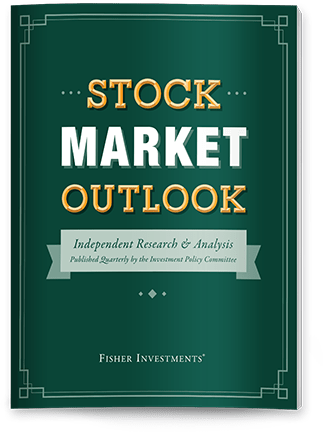Personal Wealth Management / Politics
This Week in Trade Deals
The latest unveilings ahead of August 1’s deadline.
Please note that MarketMinder favors no politician nor any party, assessing developments solely for their potential market, economic or personal finance impact.
After President Donald Trump’s July 9 can kick on Liberation Day tariffs’ resumption to August 1, his administration has struck a few deals with trading partners, lowering uncertainty further. While open questions remain for other major trading partners (e.g., the EU and China), the latest agreements underscore how reality is turning out better than feared—and why global stocks continue rising.
When Trump initially unveiled “reciprocal” tariff rates in April, one possible scenario we saw was him using the surprisingly high rates as leverage to spur trade deal talks along. Some in the administration seemingly concurred, noting the pleasingly parallel-numbered goal of 90 deals in 90 days—centered on the July 9 expiration of reciprocal tariffs’ 3-month pause, later extended to August 1. Now, 90 deals haven’t yet materialized, but some have—with Japan, Indonesia and the Philippines becoming the fourth, fifth and sixth this week. While all these deals leave baseline tariffs higher than before this year—an economic negative, chiefly for America—they are smaller than the worst-case scenario markets pre-priced early on.
Japan secured the low-end rate of 15% Tuesday, down from the 25%—and 27.5% on Japanese cars—Trump threatened previously. While the baseline rate was expected, the application to autos was more surprising. Since cars make up almost 30% of Japan’s exports to the US, this was welcome news.[i] Japanese automakers’ stocks soared, as worst-case fears dissipated. But, predictably, Detroit’s Big Three immediately cried foul, claiming Japan’s rate puts their Mexican and Canadian operations at a disadvantage. After all, US auto imports from its southern and northern neighbors are subject to 25% tariffs—and are scheduled to hit 30% and 35% for Mexico and Canada, respectively, in August. We strongly suspect the issue will come up in forthcoming negotiations.
This illustrates a few things about tariffs generally. For one, they pick winners and losers—with firms frequently vacillating between opposing tariffs and seemingly wanting higher ones. The automakers and a few steel firms illustrate that this year already. Two, they often attract lobbyists in the process—with everyone wanting favoritism. Three, it illustrates the vast uncertainty and shifting sand from a sentiment perspective over tariffs. However, this is well known to stocks, and they move most on surprise. A year ago, a 15% tax on Japanese imports would have been a huge negative shock. Now, after facing much higher prospective rates, relief.
As for Japan’s side of the bargain, Tokyo promised US-bound investment and loan guarantees up to $550 billion in areas related to national security (e.g., semiconductors, steel, shipbuilding, aviation, energy and AI) and could enter an LNG joint venture in Alaska. Japan also agreed to increase imports of US rice by 75%, buy $8 billion in other agricultural products and purchase 100 aircraft from an industry titan that rhymes with “glowing.”
How new all that promised investment is, and how all this will work, remain unclear. The LNG terminal, for example, is a major project mooted for decades. But whether Japan’s commitment to it is sufficient for it to advance now isn’t certain. Moreover, are these binding agreements? And will Trump direct where the funds go—with the US taking 90% of the profits—as he wrote in his social media post announcing the deal? Uncertainty over that lingers, but more important for stocks in the here and now: However it shakes out, the main bearish risk of escalating retaliation with America’s trade partners seems to be fading.
Need more proof? On July 15, Trump announced a trade deal with Indonesia, reducing its scheduled 32% rate to 19%. Meanwhile, there will be no tariffs on most Indonesian imports of US goods. Jakarta also committed to buying $15 billion in US energy, $4.5 billion in US agricultural products and $3.2 billion in American-made aircraft.[ii] Notably, though, copper—a major Indonesian export—is still subject to the US’s 50% metals levy, highlighting how some high trade barriers linger.
Then also on Tuesday, somewhat overshadowed by the US-Japan deal, Indonesia agreed to drop non-tariff barriers as part of its agreement with Trump. This includes recognizing America’s car and pharmaceutical safety rules and scrapping commodity and critical mineral export controls. Again, while higher tariffs aren’t great, don’t overlook “freer” trade in other areas.
Lastly, the Philippines reached a deal Tuesday, too, lowering its American tariff to 19% from the recently threatened 20% (but up from 17% on Liberation Day). Manila will apply zero tariffs on the US, and though details remain scarce, will also seek to raise imports of US cars, soy, wheat and medicine, alongside increasing military cooperation. Note that the US-Philippines deal, like Indonesia’s and Japan’s, is only a framework for an agreement with lots of negotiations left to fill in the blanks. Those details will matter in time. But markets don’t need complete clarity to move on; better-than-feared broad frameworks are good enough for now.
So with a bit over a week to go before August 1, there is bullish, better-than-feared progress being made. They aren’t a complete win, given higher tariff rates. But these deals do blunt protectionist worries considerably. And more seem nearby: For instance, a mooted EU agreement could occur this weekend—as European Commission President Ursula von der Leyen meets Trump Sunday. Risks remain, of course. The latest data appear to show trade uncertainty weighing on—or at least scrambling—business investment. Forward-looking markets, though, are looking further ahead, and as more deals conclude, the evidence mounts that the scenarios we expected to bring compromise, ongoing trade and global growth are increasingly likely.
If you would like to contact the editors responsible for this article, please message MarketMinder directly.
*The content contained in this article represents only the opinions and viewpoints of the Fisher Investments editorial staff.
Get a weekly roundup of our market insights
Sign up for our weekly e-mail newsletter.

You Imagine Your Future. We Help You Get There.
Are you ready to start your journey to a better financial future?

Where Might the Market Go Next?
Confidently tackle the market’s ups and downs with independent research and analysis that tells you where we think stocks are headed—and why.





